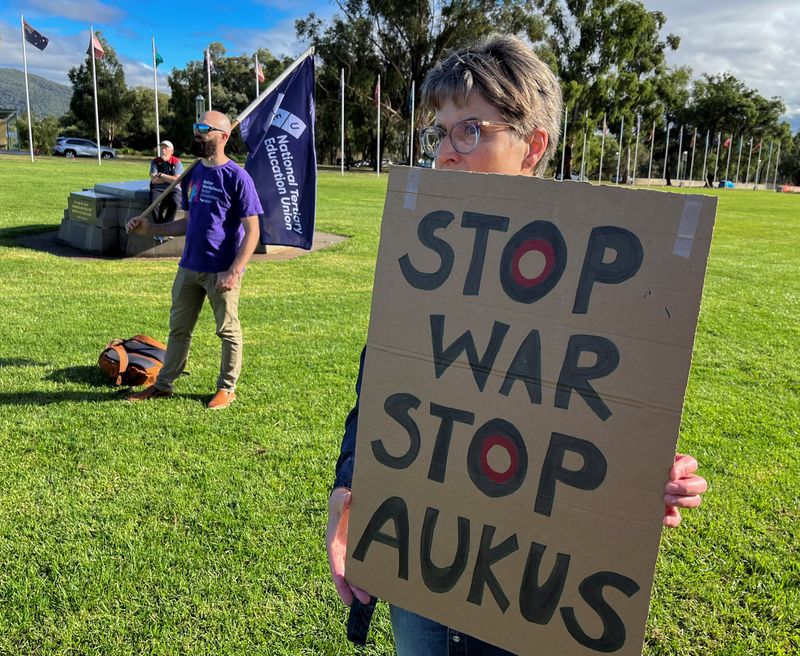AUKUS submarine base protests in Australia highlight challenges for security pact

Anti-AUKUS protesters stand outside Australia’s parliament, in Canberra, Australia, March 18, 2024. REUTERS/Lewis Jackson
By Lewis Jackson
CANBERRA (Reuters) – Fierce resistance mounted by Australian unions against plans for a new submarine base shows the challenge facing the high-stakes defence project with the United States and Britain that aims to counter China’s growing influence in the Pacific region.
Plans for the base are part of Australia’s largest defence project since World War Two, the acquisition of a fleet of nuclear-powered submarines costing up to A$368 billion ($240 billion).
That fleet is the first major deal of the AUKUS security pact, signed in 2021 between Australia, Britain and the United States, spurring Australia’s drive to build or refurbish military infrastructure.
Following backlash from unions and environmental groups, the government has said it had not decided on Port Kembla, a bastion of the ruling centre-left Labor government that media had reported to be the favoured location for the base.
“We don’t want to be part of someone else’s belligerent nuclear plans,” said Arthur Rorris, head of the South Coast Labor Council, consisting of unions representing 50,000 workers in the area.
They fear the base could choke an infant clean energy sector by taking up scarce land and ushering in security curbs, as well as the permanent presence of U.S. warships.
Rorris urged the government to abandon plans for the base while speaking at a protest on Monday outside parliament house, the latest demonstration in a series, some of which drew as many as 5,000 protesters.
Prime Minister Anthony Albanese, who inherited the pact from the previous conservative government, has defended it as necessary in the face of China’s build-up of military power in the region, which he has called the largest since World War Two.
But opposition from unions linked to his Labor Party, which is facing elections next year, reflects some public unease about the pact’s cost, use of nuclear energy and the closer ties it entails with the United States.
Former prime minister Paul Keating, an influential figure in the Labor party has called AUKUS its worst foreign policy mistake since a failed bid to introduce conscription during World War One.
But a decision on the base is not needed right away, Pat Conroy, the minister for defence industry, told Reuters.
“The east coast base is something that will be necessary a lot further down the track,” he said in an interview.
Until then, the government was focused on upgrading Australia’s sole submarine base on the west coast and preparing shipyards to build the AUKUS fleet, starting from the early 2040s, Conroy added.
REVIVAL UNLIKELY SOON
However Labor is unlikely to revive the base issue ahead of the election, for fear it could alienate voters and spur a third-party challenge in the constituency, said public policy expert Mark Kenny of the Australian National University.
“That whole area could become quite energised by this issue, that’s why I don’t think we’ll see much in the way of a decision coming soon,” Kenny added.
Workers at Port Kembla have a long history of anti-war activism, dating to World War Two.
The government can afford to delay the decision as long as the final facility is kept small, so it can be built quickly, said Peter Dean of Sydney University’s United States Studies Centre, who helped author a defence strategy review last April.
Port Kembla, surrounded by industry, near a nuclear research centre and close to deep waters that give submarines cover, had advantages over the other candidates, the cities of Brisbane and Newcastle, he added.
Yet a delay in building the base, which could take more than 10 years, could worsen recruitment problems at a time when the navy needs many more submariners to crew the bigger AUKUS fleet, said Michael Shoebridge of Strategic Analysis Australia.
A 2011 study by the defence department showed 40% of submariners at the time wanted a different location and backed the east coast for the new base.
Australia’s main submarine base is about 2,100 nautical miles from Port Kembla, on an island off Western Australia.
“Port Kembla is a logical base, but the government is trying to put the decision off,” added Shoebridge, who is also a former defence department official.
“It’s a smart domestic political decision but a dumb strategic decision.”
($1=1.5314 Australian dollars)








